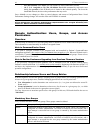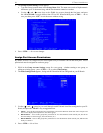
CHAPTER 4: ADMINISTRATIVE FUNCTIONS 45
Security Configuration
• Encryption mode: Toggle through the choices and select the desired level of encryption for initial
connection authentication and remote session video data transfer.
- No encryption: No encryption or security. Neither the initial connection authentication nor
remote video data transfer is encrypted.
- SSL authentication, NO data encryption: This mode secures user names and passwords,
but not KVM data. 128-bit Secure Socket Layer (SSL) protocol provides a private
communications channel between IP-Reach and the Remote PC during initial connection
authentication. No encryption security in place during remote KVM data transfer.
- SSL authentication, data encryption (default): This mode secures user names, passwords,
and KVM data. 128-bit Secure Sockets Layer (SSL) protocol provides a private
communications channel between IP-Reach and the Remote PC during initial connection
authentication. After authentication, KVM data is also transferred with 128-bit encryption, but
using a proprietary protocol more efficient than SSL.
- SSL authentication, SSL data encryption: This mode secures user names and passwords,
and provides high-level security for KVM data. 128-bit Secure Sockets Layer (SSL) protocol
provides a private communications channel between IP-Reach and the Remote PC during
initial connection authentication. 128-bit SSL encryption is also in place during remote KVM
data transfer.
Note: SSL data encryption increases the amount of data that must be sent over the remote connection, and
is, therefore, not recommended for modem or very slow Internet connections. The default setting “SSL
authentication, data encryption” offers exactly the same level of security with a higher level of efficiency.
• Remote link blanks user port: Determines whether Direct Analog User port will be blanked out
locally when a remote user is accessing the corresponding KVM port. This keeps a local user from
seeing what the remote user is doing.
- NO (default): User port can be viewed locally during remote user access.
- YES: User port cannot be viewed locally during remote user access. The local or Direct
Analog user console will stop displaying video.
Note: User Consoles can be attached to User Ports 1 through 4. Each User Console will view the path of
the matching KVM Port. For example, the User Console attached to User Port 1 will view the KVM path
attached to KVM Port 1. Similarly, the User Console attached to User Port 2 will view the KVM path
attached to KVM Port 2, and so on.
• Allow remote administration:
- NO: To keep access to all Administrative Functions available only from the IP-Reach Admin
Console, and not from a Remote PC.
- YES (default): Allows remote access to all Administrative IP-Reach Functions by
administrators logged on at a Remote PC. See 9. Remote Administration.


















